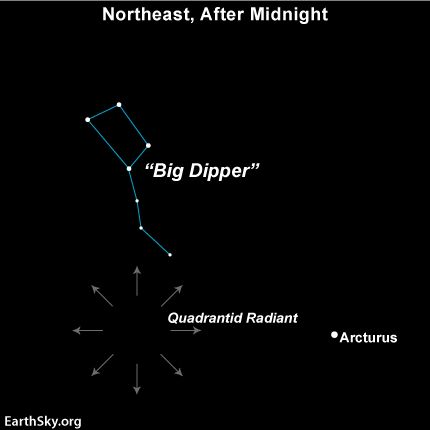
On Sunday night, the Earth will pass through a field of debris left behind by an extinct comet. That debris — bits of rock and dust — will ignite when it enters our atmosphere, streaking across the night sky.
The event is called the Quadrantid meteor shower, and it will be the first great celestial show of 2016.
With a peak of just a few hours, it will also be the briefest meteor shower of the year (most meteor showers peak over a couple of days). But it’s perhaps the most dazzling. “During its peak, 60 to as many as 200 Quadrantid meteors can be seen per hour under perfect conditions,” NASA reports. These fireballs will be larger and brighter than the average meteor shower.
The shower can be seen across most of the Northern Hemisphere starting around 3 am on Monday, January 4. Here’s a guide to how it formed and how to see it.
Where did the Quadrantid meteor shower come from?
Though the Quadrantid meteor shower has been observed by astronomers since 1825, scientists have only recently discovered the source of the debris. SETI astronomer Peter Jenniskens proposed in 2003 that a recently discovered space rock, 2003 EH1, was the source.
Originally thought to be an asteroid, 2003 EH1, as Jenniskens discovered, was actually the remainder of a comet that had broken up some 500 years earlier. (An extinct comet resembles an asteroid, as all the ice and tail of the comet has evaporated, leaving just a rocky or icy core.) According to the New York Times, historical records indicate the comet was last seen intact in 1491 in Southeast Asia.
It’s those remains of the comet that cause the light show in the sky.
What’s with the weird name: “Quadrantids”?
Meteor showers are named for the constellations from which they appear to radiate.
The Quadrantids take their name from the constellation “Quadrans Muralis.”
Quadrans Muralis depicts a mural quadrant, an astronomical device used to plot stars. (A kind of boring object for a constellation, if you ask me.) Perhaps that’s why astronomers no longer recognize Quadrans Muralis as an official constellation.
How can I watch the Quadrantid shower?
The meteor shower will peak between 3 am and dawn January 4 (early Monday morning),according to EarthSky.org. Luckily, the moon will be a dim, slim crescent, and won’t interfere with seeing the meteors shoot across the sky.
The meteor shower should be visible for most of the Northern Hemisphere, with Alaska and Hawaii being the best states for viewing. (It can be seen as far South as Puerto Rico.) According to EarthSky.org the meteors will radiate out from a spot right near the Big Dipper constellation.
/cdn0.vox-cdn.com/uploads/chorus_asset/file/5865955/Quadrantid_meteor_shower_radiant_point.0.jpeg)
For ideal viewing: Find a place with clear skies that’s far from the light pollution of a city. This interactive map will help you find the darkest areas of the country. The more middle of nowhere, the better. And bring a sleeping bag or blanket with you. It’s January, after all.
If you miss the shower itself, all’s not lost. A few shooting stars might be visible each night from January 1 to 6, In-the-Sky.org reports.
/cdn0.vox-cdn.com/uploads/chorus_asset/file/5865961/612767main_quadrantids_lg.0.jpg)
False-color image of a rare early Quadrantid, captured by a NASA meteor camera in 2010. (NASA/MEO/B. Cooke)
